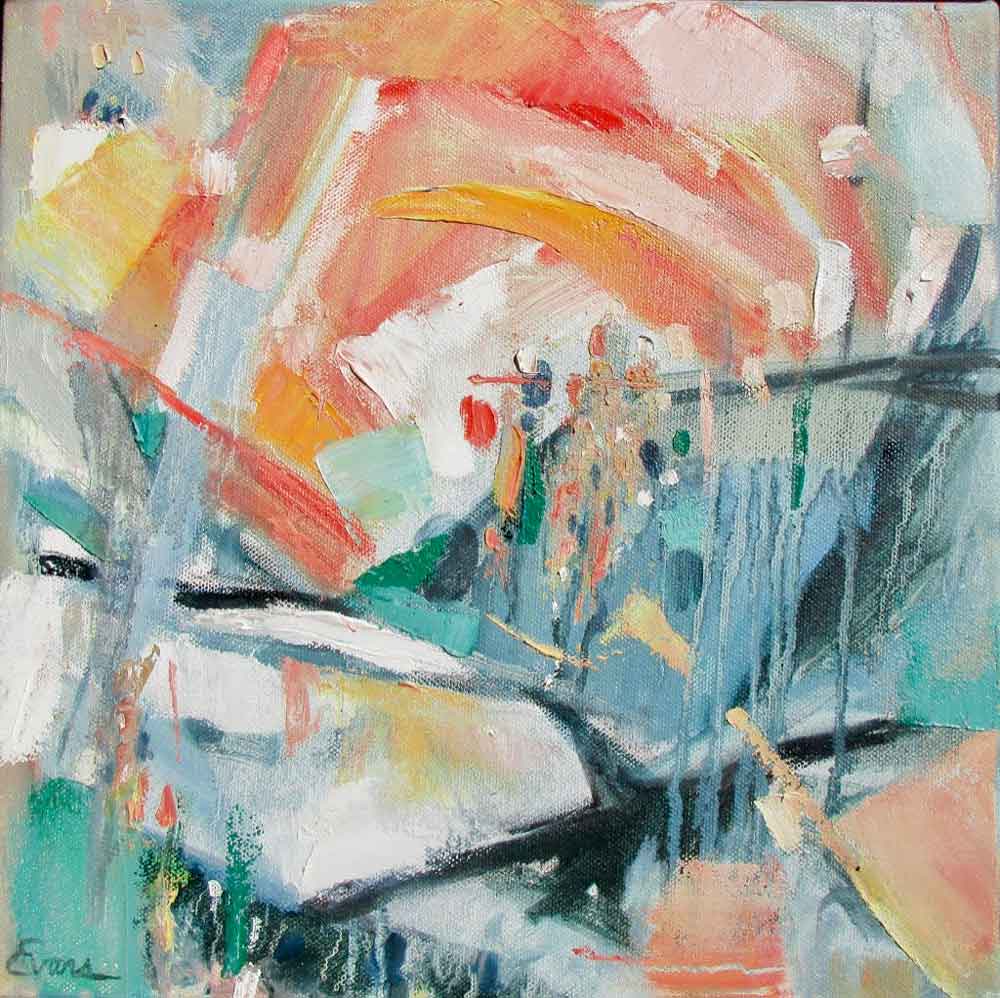Often I am asked why I paint abstracts. It is not an easy thing to explain. Often people say “I like the kind of art that looks like something.” They want reality as determined by the five senses, especially by sight. In contemporary/modern/abstract/non-objective art, however, material things are not the focus; the unseen is. Design itself, feelings, emotions, ideas, spiritual concepts, are the domain of the abstract. Because I value spiritual ideas, I like the learning that takes place when one tries to grapple with, understand, and express that which is unseen. It involves listening and receiving a gift of interior knowing.
Listening allows what wants to be born to come forth, to wander on the canvas, to show me something I may not even have understood before. Or perhaps I did. It is delving into a kind of truth beyond the observed. Beyond information gained by the senses. Beyond what is measurable, material. The artist has to be open, sensitive to every nuance. She listens, then paints. Then listens some more. She follows the work’s lead as it develops rather than forcing set preconceptions. Abstract/non-objective/modern painting is a revealing rather than a defining. Wassily Kandinsky, who is considered the father of modern art, said “The artist must train not only his eye but also his soul.”
When I do a portrait, I’m involved in measuring most accurately the distance between the eyes or the ratio of space between nose and mouth, etc. Careful observation is crucial to accuracy and accuracy is essential in portraiture–a quarter of an inch off in the smallest area can negate likeness. But I also care to express who the person is more deeply than just physical attributes. I
search to uncover what constitutes his identity, his very being. This latter aspect is not gained by measurement or scientific study of anatomy. It comes with mental awareness of what is true but physically unseen. So even a very realistic piece includes that which is beyond appearances.
Now imagine you are creating a large oil abstract–not a portrait. Where do you begin? Perhaps you are setting out to show some particular truth. There may be qualities to truth, its strength, its ability to break through lies, its innate goodness, that conjures up certain strong strokes, colors, shapes, or particular movement on the surface. Or you may choose to do a non-objective piece without didactic intent. It may deal entirely with the elements of line, shape, form, color, value, etc.–how they create a united design or harmony.
I begin an abstract by drawing. Drawing is at the heart of all art-making. Usually with charcoal or a brush load of bold black oil and turpentine. I do not dictate where my marks go. I let them come. Sometimes I play music; like painting, it dances in the realm of spirit. Sometimes I rotate the canvas, working from all four sides so as not to have a closed vision from only one viewpoint. I observe what appears on the canvas and where it leads my hand. One bit leads to the next. Sometimes I rub out a bit. Subtraction is as important as addition. Also layers, transparency, opaqueness–all are important. Sometimes there may be frustration, but more frequently a pleasing design begins to occur. I follow it. Time is no measure of what counts. Listening and following is all that matters.
The artist is the obedient servant of the work that is being born. Not unlike a human mother giving birth, she does not dictate how the birth will be, she merely facilitates it, is open to the event, anticipatory of the creation, willing to work intently for its arrival, excited to behold the glorious coming.
But unlike human birth, in art, knowing when to stop can be difficult. Would a bit of orange enhance the focal area–or would a dollop of white be the perfect final touch? Throughout, trial-and-error is part of the process, as are continual addition and subtraction. New things happen. One may courageously accept them even if a new direction is suggested. When a growing sense of satisfaction is felt, and if the piece speaks to you: “Aha! I’m done!” you will know the work is finished. If all along you’ve been listening, you will know the end has come. You sign your name. And rest.
Artwork: Truth’s Light Breaking Through, oil on canvas, 12″ x 12″, $475. A small favorite among my many abstracts. Combines my thoughts about the power of Truth and as well as all I’ve written above about the value of abstraction.
